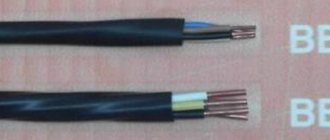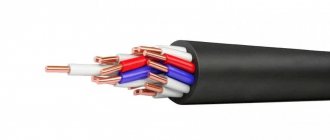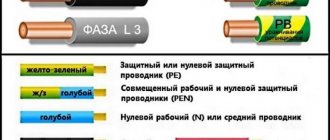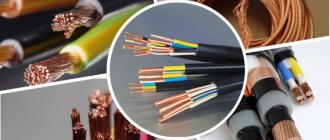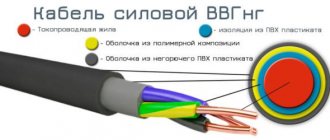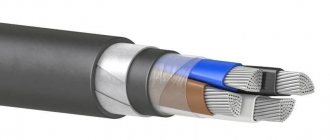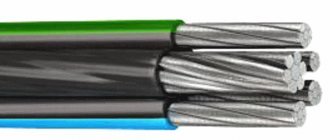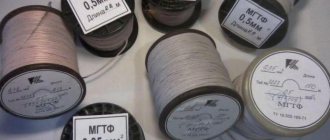When installing electrical wiring in an apartment or private house, it is very important to choose the correct wire cross-section. If you take a cable that is too thick, it will cost you a pretty penny, since its price directly depends on the diameter (section) of the conductors. The use of a thin cable leads to its overheating and if the protection does not work, the insulation may melt, a short circuit and, as a result, a fire. The most correct choice would be the wire cross-section depending on the load, which is reflected in the tables below.
Cable cross-section
The cable cross-section is the cut area of the current-carrying core. If the cut of the core is round (as in most cases) and consists of one wire, then the area/section is determined by the formula for the area of a circle. If there are many wires in the core, then the cross-section will be the sum of the cross-sections of all the wires in this core.
The cross-sectional values are standardized in all countries, and the standards of the former CIS and Europe in this part completely coincide. In our country, the document that regulates this issue is the “Rules for the Construction of Electrical Installations” or briefly - PUE.
The cable cross-section is selected based on the loads using special tables called “Permissible current loads on the cable.” If you have no desire to understand these tables, then it is enough for you to know that it is advisable to use a copper cable with a cross-section of 1.5-2.5 mm² for sockets, and 1.0-1.5 mm² for lighting.
To introduce one phase into an ordinary 2-3 room apartment, 6.0 mm² is quite enough. All the same, your 40-80 m² will not fit larger equipment, even taking into account the electric stove.
Many electricians, in order to “estimate” the required cross-section, believe that 1mm² of copper wire can pass 10A of electric current through itself: accordingly, 2.5 mm² of copper can pass 25A, and 4.0 mm² - 40A, etc. If you analyze the cable cross-section selection table a little, you will see that this method is only suitable for estimation and only for cables with a cross-section no higher than 6.0 mm².
Below is an abbreviated table for selecting cable cross-sections up to 35 mm² depending on current loads. For your convenience, the total power of electrical equipment is given there for 1-phase (220V) and 3-phase (380V) consumption.
When laying the cable in a pipe (i.e. in any closed spaces), the possible current loads on the cable should be less than when laying it openly. This is due to the fact that the cable heats up during operation, and heat transfer in a wall or in the ground is much lower than in open space.
When the load is called in kW, we are talking about the total load. Those. for a single-phase consumer, the load will be indicated for one phase, and for a three-phase consumer - in total for all three. When the load value is named in amperes (A), we are always talking about the load on one core (or phase).
Load table for cable cross-section:
| Cable cross-section, mm² | Laid open | Installed in a pipe | ||||||||||
| copper | aluminum | copper | aluminum | |||||||||
| current, A | power, kWt | current, A | power, kWt | current, A | power, kWt | current, A | power, kWt | |||||
| 220V | 380V | 220V | 380V | 220V | 380V | 220V | 380V | |||||
| 0.5 | 11 | 2.4 | ||||||||||
| 0.75 | 15 | 3.3 | ||||||||||
| 1 | 17 | 3.7 | 6.4 | 14 | 3 | 5.3 | ||||||
| 1.5 | 23 | 5 | 8.7 | 15 | 3.3 | 5.7 | ||||||
| 2.5 | 30 | 6.6 | 11 | 24 | 5.2 | 9.1 | 21 | 4.6 | 7.9 | 16 | 3.5 | 6 |
| 4 | 41 | 9 | 15 | 32 | 7 | 12 | 27 | 5.9 | 10 | 21 | 4.6 | 7.9 |
| 6 | 50 | 11 | 19 | 39 | 8.5 | 14 | 34 | 7.4 | 12 | 26 | 5.7 | 9.8 |
| 10 | 80 | 17 | 30 | 60 | 13 | 22 | 50 | 11 | 19 | 38 | 8.3 | 14 |
| 16 | 100 | 22 | 38 | 75 | 16 | 28 | 80 | 17 | 30 | 55 | 12 | 20 |
| 25 | 140 | 30 | 53 | 105 | 23 | 39 | 100 | 22 | 38 | 65 | 14 | 24 |
| 35 | 170 | 37 | 64 | 130 | 28 | 49 | 135 | 29 | 51 | 75 | 16 | 28 |
To independently calculate the required cable cross-section, for example, for entry into a house, you can use a cable calculator or select the required cross-section from the table.
This table applies to cables and wires with rubber and plastic insulation. These are such widespread brands as: PVS, GDP, VPP, PPV, APPV, VVG. AVVG and a number of others. Paper-insulated cables have their own table, and non-insulated wires and buses have their own.
When calculating the cable cross-section, the specialist must also take into account the methods of laying the cable: in trays, in bundles, etc.
- In addition, the values from the tables on permissible current loads must be adjusted by the following reduction factors:
- correction factor corresponding to the cable cross-section and its location in the block;
- correction factor for ambient temperature;
- correction factor for cables laid in the ground;
- correction factor for different numbers of operating cables laid nearby.
Application area
Cables of the VVGng brand are used for transmission and distribution of electric power with stationary installation at a rated alternating voltage of 0.66 kV and 1 kV frequency of 50 Hz.
VVGng cables are intended for use indoors, outdoors, electrical installations (ducts, pipes, trays, tunnels, etc.) in the absence of tensile loads on the cable.
VVGng cables are used in cases where increased fire safety is required to prevent the spread of combustion when laying cables in bundles. Corresponds to category A GOST 12176.
Calculation of wire cross-section
Let's start not with a table, but with a calculation. That is, each person, without having the Internet at hand, where the PUE with tables is freely available, can independently determine the cable cross-section by current. To do this you will need a caliper and a formula.
If we consider the cross-section of the cable, it is a circle with a certain diameter. There is a formula for the area of a circle: S = 3.14*D²/4, where 3.14 is the Archimedean number, “D” is the diameter of the measured core. The formula can be simplified: S=0.785*D².
If the wire consists of several cores, then the diameter of each is measured, the area is calculated, then all the indicators are summed up. How to calculate the cross-section of a cable if each core consists of several thin wires?
The process becomes a little more complicated, but not much. To do this, you will have to count the number of wires in one core, measure the diameter of one wire, calculate its area using the described formula and multiply this figure by the number of wires. This will be the cross section of one core. Now you need to multiply this value by the number of cores.
If you don’t want to count the wires and measure their sizes, you just need to measure the diameter of one core, consisting of several wires. You must take measurements carefully so as not to crush the core. Please note that this diameter is not exact because there is space between the wires.
Relation between current and cross section
To understand how an electrical cable works, you need to remember a regular water pipe. The larger its diameter, the more water will pass through it. It's the same with wires.
The larger their area, the greater the current that will pass through them, the greater the load such a wire can withstand. In this case, the cable will not overheat, which is the most important requirement of fire safety rules.
Therefore, the cross-section - current connection is the main criterion that is used in the selection of electrical wires in the wiring. Therefore, you need to first figure out how many household appliances and what total power will be connected to each loop.
| Wire core cross-section, mm2 | Copper conductors | Aluminum conductors | ||
| Current, A | Power, W | Current, A | Power, W | |
| 0.5 | 6 | 1300 | ||
| 0.75 | 10 | 2200 | ||
| 1 | 14 | 3100 | ||
| 1.5 | 15 | 3300 | 10 | 2200 |
| 2 | 19 | 4200 | 14 | 3100 |
| 2.5 | 21 | 4600 | 16 | 3500 |
| 4 | 27 | 5900 | 21 | 4600 |
| 6 | 34 | 7500 | 26 | 5700 |
| 10 | 50 | 11000 | 38 | 8400 |
| 16 | 80 | 17600 | 55 | 12100 |
| 25 | 100 | 22000 | 65 | 14300 |
For example, the kitchen must have a refrigerator, microwave, coffee grinder and coffee maker, an electric kettle and sometimes a dishwasher. That is, all these devices can be turned on simultaneously at the same time. Therefore, the total power of the room is used in the calculations.
You can find out the power consumption of each device from the product passport or on the tag.
- For example, let's designate some of them:
- Kettle – 1-2 kW.
- Microwave and meat grinder 1.5-2.2 kW.
- Coffee grinder and coffee maker – 0.5-1.5 kW.
- Refrigerator 0.8 kW.
Having found out the power that will act on the wiring, you can select its cross-section from the table. We will not consider all the indicators in this table; we will show those that prevail in everyday life.
How to correctly determine the wire cross-section
The value of the rated current on the input cable to the apartment depends on how many consumers are connected. The table shows the necessary devices and their power.
| electrical appliance | Rated power, kW |
| TV | 0,18 |
| Boiler | 2-6 |
| Fridge | 0,2-0,3 |
| Oven | 2-5 |
| Vacuum cleaner | 0,65-1 |
| Electric kettle | 1,2-2 |
| Iron | 1,7-2,3 |
| Microwave | 0,8-2 |
| Computer | 0,3-1 |
| Washing machine | 2,5-3,5 |
| Lighting system | 0,5 |
| Total | 12,03-23,78 |
We invite you to familiarize yourself with: Floor joists: the size of the timber and the distance between the joists, the table and how to strengthen the floors, the arrangement in the house
I = P∙Ki/(U∙cos φ), where Ki = 0.75 is the simultaneity coefficient.
For most electrical appliances that are active loads, the power factor cos φ = 1. For fluorescent lamps, electric motors of a vacuum cleaner, washing machine, etc., it is less than 1 and must be taken into account.
The long-term permissible current for the devices given in the table will be I = 41 - 81 A. The value turns out to be quite impressive. When purchasing a new electrical appliance, you should always think carefully about whether your apartment network will support it. According to the table for open wiring, the cross-section of the input wire will be 4-10 mm2.
Here you also need to take into account how the apartment load will affect the general building load. It is possible that the housing office will not allow connecting so many electrical appliances to the entrance riser, where a busbar (copper or aluminum) passes through the distribution cabinets under each phase and neutral. They simply won’t be able to handle the electricity meter, which is usually installed in a switchboard on the landing. In addition, the fee for excess consumption of electricity will increase to impressive sizes due to increasing coefficients.
If wiring is done for a private house, then the power of the outlet wire from the main network must be taken into account. The commonly used aluminum wire SIP-4 with a cross-section of 12 mm2 may not be enough for a heavy load.
We're done with the theory. It’s time to move on to the main question of the topic - how to determine the required cross-section of the current-carrying conductor for various operating conditions of electrical wiring.
There are several options for finding the desired result.
You can choose the one that seems most convenient or suitable for a particular case.
From everything stated above, it should already be clear that the main limiter when choosing the required cross-section is resistive heating of the conductors, which can lead to melting of the insulation, short circuits, overheating of surrounding materials, up to the possibility of spontaneous combustion.
That is, the selected wire cross-section should exclude such phenomena.
Carrying out accurate thermal calculations is a very difficult matter. But experts have already done a lot in this regard, so you can take advantage of their work.
In particular, they calculated a safe current density that does not cause dangerous heating of the conductor to temperatures that could cause melting of the most common PVC or PE insulation nowadays.
| Optimal current density, A/mm² | ||
| Wiring Location | Open | Closed |
| 3.5 | 3 | |
| 5 | 4 | |
Let’s immediately clarify the difference between open and closed wiring.
- Open is not so common. It is laid along walls or ceilings using clamps or insulators; it can be airborne - self-supporting or held by a supporting cable. Open wiring also includes power cords and extension cords, unless, of course, they are wound on coils, bobbins, etc.
- Everything else, in fact, is closed wiring: located in cable ducts, ducts or corrugated pipes, embedded in walls, laid in the ground, etc. In other words, in any conditions where there is no normal heat dissipation. Based on this criterion, closed wiring should also include those areas that are located in distribution boards and installation boxes - there is no normal heat exchange here either.
It was not for nothing that it was stated above that the indicated indicators are valid for room temperature. It happens that wiring has to be laid in rooms with a special temperature regime, that is, in which heating is maintained above normal (dressing rooms, dryers, greenhouses, etc.) In this case, adjustments are made to the value of the permissible current density - a coefficient of 0.9 per every 10 degrees temperature above 20 ℃.
For example, what current density should you focus on if you plan to lay copper wiring in a cable duct to connect a heating element in a dryer in which the temperature will be maintained at 50 ℃?
According to the table, the current density G for closed copper wiring is 4 A/mm².
The difference between the temperature norm and the planned regime is
50 – 20 = 30 ℃.
G = 4 × 0.9 × 0.9 × 0.9 = 4 × 0.9³ = 4 × 0.729 = 2.92 A/mm²
You will have to focus on this density indicator to create wiring that is safe under these conditions.
One more example. Let's say, in the conditions already discussed, wiring is laid to connect two heaters with a power of 750 watts each.
P = 750 750 = 1500 W
I = P / U = 1500 / 220 = 6.8 A
S = I / G = 6.8 / 2.92 = 2.33 mm²
Naturally, the resulting value is reduced to the nearest one, rounded up. That is, for laying wiring under the specified conditions, a copper wire with a cross-section of 2.5 mm² is suitable.
In principle, the same principle can be used to carry out calculations for any other premises. Including for lines to which it is planned to connect several electrical appliances of varying power.
ΣP = (P₁ Р₂ … Рₙ) × Кс × Кз
In brackets are the powers of electrical appliances connected to the line, from 1 to n.
Kc is the so-called demand coefficient. It is unlikely that all devices connected in the line will work simultaneously. That is, this coefficient takes into account the probability of their simultaneous inclusion.
Calculating this coefficient is not an easy task, as it takes into account many nuances. But since our publication is intended for amateur electricians, whose work is probably limited to their small residential properties, we can simplify the task. Specifically: with two devices, we leave the coefficient equal to one.
Кз – safety factor. The value is optional. But a prudent owner can think ahead that, perhaps, in a year or two, an additional load will have to be connected to the same line, which can only be guessed at for now. So it makes sense to immediately lay down a reserve by taking a coefficient, for example, from 1.5 to 2.0. But, we repeat, the matter is voluntary, and this coefficient can be completely excluded from the calculations.
Another important point. The actual power of an electrical device may be higher than the nominal power indicated in the passport. This is related to the concepts of active and reactive power.
We invite you to familiarize yourself with: Table for selecting machines by power and current
Pп = Pn / cos φ
Pп — total power;
Pn is the rated power indicated in the passport;
cos φ - power factor equal to the cosine of the angle φ - phase displacement of current and voltage.
This displacement is typical for devices with a powerful electric drive, with a high inductive load (transformers, chokes). The cos φ value for such equipment is also indicated in the product passport.
Values of rated power and cos φ on the nameplate of an asynchronous motor
In everyday life, such devices are rarely found, but still, if a line is installed, say, to power a powerful pump, compressor, electric motor, or for a welding station, it is better not to skimp on this indicator.
Now you can try to make a full calculation, taking into account everything said above. For this, the reader is offered an online calculator.
You must enter the requested data in the program input fields:
- What wiring will be used: copper or aluminum, open or closed.
- Voltage in the planned line.
- If a specific temperature regime is expected in the room, then this should be indicated - choose from the proposed options. A room temperature below 25℃ will be considered normal - it is listed first and is taken into account by default.
- Next, the power of the load planned for connection is indicated. There are up to 6 different units - this is usually enough for domestic conditions. Moreover, if the field is not filled in, then the power is considered equal to zero, that is, the field is not taken into account.
The last two fields allow you to take into account the load with a reactive power component, if any. To do this, in addition to the nominal value, you must also indicate the cos φ value. By default, cos φ = 0, that is, as for a regular active load.
- Depending on the number of devices connected to the line, the algorithm automatically takes into account the demand coefficient.
- Finally, the user can reserve power by increasing the safety factor, from 1 to 2 in increments of 0.1.
The calculation result will be given in square millimeters of the cross-section of the wire (cable) core with an accuracy of one hundredth. Naturally, after this you will have to round up to the nearest standard size.
What is the difference between a cable and a wire?
Before moving on to the main content, we need to understand what we still want to calculate, the cross-section of a wire or cable, what are the differences between one and the other!? Despite the fact that the average person uses these two words as synonyms, meaning by this something of their own, but if we are meticulous, there is still a difference.
So a wire is one conductive core, be it a single core or a set of conductors, insulated into a dielectric, into a sheath. But a cable is already several such wires combined into a single whole, in its own protective and insulating sheath. In order for you to better understand what's what, take a look at the picture.
So, now we know that we need to calculate exactly the cross-section of the wire, that is, one conductive element, and the second will already move away from the load, back to the power supply.
However, sometimes we ourselves forget ourselves no better than you, so if you catch us by the fact that somewhere you still come across the word cable, then do not consider it ignorance, stereotypes do their job.
Cable selection
It is best to make internal wiring using copper wires. Although aluminum ones are not inferior to them. But there is one nuance here, which is associated with the correct connection of sections in the distribution box. As practice shows, connections often fail due to oxidation of the aluminum wire.
Another question is which wire to choose: single-core or stranded? Single-core has better current conductivity, so it is recommended for use in household electrical wiring. Multicore has high flexibility, which allows it to be bent in one place several times without compromising quality.
Single or stranded
When installing electrical wiring, wires and cables of the PVS, VVGng, PPV, APPV brands are usually used. This list contains both flexible cables and monocore cables.
Here we would like to tell you one thing. If your wiring will not move, that is, it is not an extension cord, or a bend point that constantly changes its position, then it is preferable to use a monocore.
You will ask why? It's simple! No matter how well the conductors are laid in the protective insulating braid, air containing oxygen will still get under it. Oxidation of the copper surface occurs.
As a result, if there are many conductors, then the oxidation area is much larger, which means the current-carrying cross-section “melts” much more. Yes, this is a long process, but we don’t think that you are going to change the wiring often. The more she works, the better.
This oxidation effect will be especially pronounced at the edges of the cable cut, in rooms with temperature changes and high humidity. So we strongly recommend that you use monocore! The cross-section of a monocore cable or wire will change slightly over time, and this is so important for our further calculations.
Copper or aluminum
In the USSR, most residential buildings were equipped with aluminum wiring; this was a kind of norm, standard, and even dogma. No, this does not mean at all that the country was poor and there was a shortage of copper. Even in some cases it's the other way around.
But apparently the designers of electrical networks decided that they could save a lot economically if they used aluminum rather than copper. Indeed, the pace of construction was enormous; just remember the Khrushchev buildings, in which half of the country still lives, which means the effect of such savings was significant. There is no doubt about this.
However, today the realities are different, and aluminum wiring is not used in new residential premises, only copper. This is based on the rules of the PUE, clause 7.1.34 “Cables and wires with copper conductors should be used in buildings...”.
So, we strongly do not recommend that you experiment and try aluminum. Its disadvantages are obvious. Aluminum strands cannot be soldered and are also very difficult to weld; as a result, the contacts in the junction boxes may break over time. Aluminum is very fragile, two or three bends and the wire falls off.
There will be constant problems connecting it to sockets and switches. Again, if we talk about conducted power, then a copper wire with the same cross-section for aluminum is 2.5 mm2. allows a continuous current of 19A, and for copper 25A. Here the difference is more than 1 kW.
So let’s repeat it again - only copper! Further, we will proceed from the fact that we are calculating the cross-section for a copper wire, but in the tables we will also give values for aluminum. You never know.
Why is the calculation made?
Wires and cables that carry electrical current are the most important part of electrical wiring.
The wire cross-section must be calculated to ensure that the selected wire meets all the requirements for reliability and safe operation of electrical wiring.
Safe operation is that if you choose a cross-section that does not correspond to its current loads, this will lead to excessive overheating of the wire, melting of the insulation, short circuit and fire.
Therefore, the issue of choosing a wire cross-section must be taken very seriously.
What you need to know
The main indicator by which a wire is calculated is its long-term permissible current load. Simply put, this is the amount of current that it is capable of passing for a long time.
To find the rated current value, you need to calculate the power of all connected electrical appliances in the house. Let's consider an example of calculating the wire cross-section for an ordinary two-room apartment.
Table of power/current consumption of household electrical appliances
| electrical appliance | Power consumption, W | Current strength, A |
| Washing machine | 2000 – 2500 | 9,0 – 11,4 |
| Jacuzzi | 2000 – 2500 | 9,0 – 11,4 |
| Electric floor heating | 800 – 1400 | 3,6 – 6,4 |
| Stationary electric stove | 4500 – 8500 | 20,5 – 38,6 |
| microwave | 900 – 1300 | 4,1 – 5,9 |
| Dishwasher | 2000 – 2500 | 9,0 – 11,4 |
| Freezers, refrigerators | 140 – 300 | 0,6 – 1,4 |
| Electric meat grinder | 1100 – 1200 | 5,0 – 5,5 |
| Electric kettle | 1850 – 2000 | 8,4 – 9,0 |
| Electric coffee maker | 630 – 1200 | 3,0 – 5,5 |
| Juicer | 240 – 360 | 1,1 – 1,6 |
| Toaster | 640 – 1100 | 2,9 – 5,0 |
| Mixer | 250 – 400 | 1,1 – 1,8 |
| Hairdryer | 400 – 1600 | 1,8 – 7,3 |
| Iron | 900 –1700 | 4,1 – 7,7 |
| Vacuum cleaner | 680 – 1400 | 3,1 – 6,4 |
| Fan | 250 – 400 | 1,0 – 1,8 |
| TV | 125 – 180 | 0,6 – 0,8 |
| Radio equipment | 70 – 100 | 0,3 – 0,5 |
| Lighting devices | 20 – 100 | 0,1 – 0,4 |
Once the power is known, the calculation of the cross-section of a wire or cable comes down to determining the current strength based on this power. You can find the current strength using the formula:
1) Formula for calculating current for a single-phase 220 V network:
current calculation for a single-phase network
where P is the total power of all electrical appliances, W; U—mains voltage, V; CI = 0.75 - simultaneity coefficient; cos for household electrical appliances - for household electrical appliances. 2) Formula for calculating the current in a three-phase 380 V network:
current calculation for a three-phase network
Knowing the magnitude of the current, the wire cross-section is found from the table. If it turns out that the calculated and tabulated current values do not coincide, then in this case the nearest larger value is selected. For example, the calculated current value is 23 A, we select the nearest larger one from the table, 27 A - with a cross-section of 2.5 mm2.
Which wire is better to use
Today, for installation of both open and hidden electrical wiring, copper wires are, of course, very popular.
- Copper, compared to aluminum, is more effective:
- it is stronger, softer and does not break in places of inflection compared to aluminum;
- less susceptible to corrosion and oxidation. When connecting aluminum in a junction box, the twist points oxidize over time, which leads to loss of contact;
- The conductivity of copper is higher than that of aluminum; with the same cross-section, a copper wire can withstand a higher current load than aluminum.
The disadvantage of copper wires is their high cost. Their cost is 3-4 times higher than aluminum ones. Although copper wires are more expensive, they are still more common and popular in use than aluminum wires.
How to calculate three-phase wiring?
Table values cannot take into account the individual characteristics of the device and network operation. The specificity of the tables is average. They do not list the parameters of the maximum permissible currents for a particular cable, but they differ for products of different brands. The type of gasket is touched upon very superficially in the tables.
Let's start with mastering the basics: remember in practice the derived interval 6 - 10. These are the values obtained by electricians over many years of “experimental methods”. The strength of the current flowing through 1 mm² of copper core varies within the specified limits. Those. a cable with a copper core with a cross-section of 1 mm² without overheating and melting of the insulation allows a current of 6 to 10 A to easily reach the waiting consumer unit. Let's figure out where it came from and what the designated interval fork means.
According to the code of electrical laws PUE, 40% is allocated to the cable for overheating that is not dangerous for its sheath, which means:
- 6 A distributed per 1 mm² of current-carrying core is the normal operating current density. Under these conditions, the conductor can work indefinitely without any time restrictions;
- 10 A distributed per 1 mm² of copper core can flow through the conductor for a short time. For example, when you turn on the device.
We invite you to familiarize yourself with Bath cables to buy in Moscow inexpensively - sale, cost.
Order a cable for a bath, price in the online store. An energy flow of 12 A in a copper millimeter channel will initially be “crowded”. Due to the crowding and crowding of electrons, the current density will increase. The temperature of the copper component will then increase, which will invariably affect the condition of the insulating shell.
Please note that for a cable with aluminum current-carrying conductor, the current density displays an interval of 4 - 6 Amperes per 1 mm² of conductor.
We found out that the maximum current density for a conductor made of electrical copper is 10 A per cross-sectional area of 1 mm², and normal is 6 A. Therefore:
- a cable with a conductor cross-section of 2.5 mm² will be able to transport a current of 25 A in just a few tenths of a second when the equipment is turned on;
- it will be able to transmit a current of 15A indefinitely.
The above current densities are valid for open wiring. If the cable is laid in a wall, in a metal sleeve or in a plastic cable channel, the specified current density value must be multiplied by a correction factor of 0.8. Remember one more subtlety in organizing open wiring. For reasons of mechanical strength, cables with a cross-section of less than 4 mm² are not used in open circuits.
There will be no super complex calculations again; calculating the wire for the upcoming load is extremely simple.
- First, let's find the maximum permissible load. To do this, we summarize the power of the devices that we plan to simultaneously connect to the line. Let's add up, for example, the power of a washing machine 2000 W, a hair dryer 1000 W and an arbitrary heater 1500 W. We received 4500 W or 4.5 kW.
- Then we divide our result by the standard voltage of a household network of 220 V. We got 20.45 ... A, round up to a whole number, as expected.
- Next, we introduce a correction factor, if necessary. The value with the coefficient will be equal to 16.8, rounded 17 A, without the coefficient 21 A.
- We remember that we calculated the operating power parameters, but we also need to take into account the maximum permissible value. To do this, we multiply the current strength we calculated by 1.4, because the correction for thermal effects is 40%. We got: 23.8 A and 29.4 A, respectively.
- This means that in our example, for safe operation of open wiring, a cable with a cross-section of more than 3 mm² will be required, and for a hidden version, 2.5 mm².
Let's not forget that, due to various circumstances, we sometimes turn on more units at the same time than we expected. That there are also light bulbs and other devices that consume little energy. Let's stock up on some reserve section in case of increasing the fleet of household appliances and, with the calculations, go for an important purchase.
The calculation of the permissible cable cross-section is influenced by the type of network. If the power consumption is the same, the permissible current loads on the cable cores for a three-phase network will be less than for a single-phase one.
We suggest you familiarize yourself with Which wire to lay in the bath
I = P/(√3∙U∙cos φ).
The power factor can be found in the characteristics of electrical appliances or it is equal to 1 if the load is active. The maximum permissible current for copper wires, as well as aluminum wires at three-phase voltage, is indicated in the tables.
Calculation of the cross-section of copper wires and cables
Having calculated the load and decided on the material (copper), let’s consider an example of calculating the cross-section of wires for individual groups of consumers, using the example of a two-room apartment.
As you know, the entire load is divided into two groups: power and lighting.
In our case, the main power load will be the socket group installed in the kitchen and bathroom. Since the most powerful equipment is installed there (electric kettle, microwave, refrigerator, boiler, washing machine, etc.).
For this socket group we select a wire with a cross section of 2.5mm2. Provided that the power load will be scattered across different outlets. What does it mean? For example, in the kitchen, to connect all household appliances, you need 3-4 sockets connected with copper wire with a cross-section of 2.5 mm2 each.
If all equipment is connected through one single socket, then a cross-section of 2.5 mm2 will not be enough, in this case you need to use a wire with a cross-section of 4-6 mm2. In living rooms, a wire with a cross section of 1.5 mm2 can be used to power sockets, but the final choice must be made after appropriate calculations.
The entire lighting load is powered by a wire with a cross section of 1.5 mm2.
It is necessary to understand that the power in different sections of the electrical wiring will be different, and accordingly the cross-section of the supply wires will also be different. Its greatest value will be in the introductory section of the apartment, since the entire load passes through it. The cross-section of the input supply wire is selected 4 - 6 mm2.
When installing electrical wiring, wires and cables of the PVS, VVGng, PPV, APPV brands are used.
Selection of cable cross-section by power
Now we get to the essence of our article. However, everything that was above cannot be missed, which means we could not remain silent.
If we try to present the idea logically and simply, then a current of a certain strength can pass through each conventional cross-section of a conductor. This conclusion is quite logical and now all that remains is to find out these ratios and correlate them for different wire diameters, based on its type series.
It also cannot be ignored that here, when calculating the current cross section, temperature also comes into play. Yes, this is a new component – temperature. It is she who can influence the cross section. How and why, let's figure it out.
We all know about Brownian motion. On the constant displacement of ions in a crystal lattice. All this happens in all materials, including conductors. The higher the temperature, the greater these vibrations of ions within the material will be. And we know that current is the directed movement of particles.
So, the directed movement of particles will collide with ions in the crystal lattice, which will lead to an increase in resistance to current.
The higher the temperature, the higher the electrical resistance of the conductor. Therefore, by default, the wire cross-section for a certain current is taken at room temperature, that is, at 18 degrees Celsius. It is at this temperature that all reference values are given in the tables, including ours.
Despite the fact that we do not consider aluminum wires as wires for electrical wiring, at least in an apartment, they are nevertheless used in many places. Let's say for wiring on the street. That is why we will also present the values of the cross-section and current dependencies for aluminum wires.
So, for copper and aluminum there will be the following indicators of the dependence of the cross-section of the wire (cable) on the current (power). See table.
Table of conductors for maximum permissible current for their use in wiring:
Since 2001, aluminum wires have not been used for wiring in apartments. (PEU)
Yes, here, as our reader noted, we actually did not provide calculations, but only provided reference data, tabulated, based on these calculations. But we dare to tell you that for calculations it is necessary to go through many formulas and indicators. Starting from temperature, resistivity, current density and the like.
Therefore, we will leave such calculations for specialists. It should be noted that they are not final, since they may vary slightly depending on the standard for the material and the current reserve of the wire used in different countries.
But what we would also like to talk about is converting the wire cross-section to diameter. This is necessary when there is a wire, but for some reason there is no marking on it. In this case, the cross-section can be calculated from the diameter of the wire, and vice versa from the diameter of the cross-section.
The procedure for calculating the permissible current for copper wires
Content
- Allowable and operating current density
- Calculation of wire cross-section
- Wire marking
- Copper conductors of wires and cables
- Selecting the diameter of the fuse wire
Electrical networks entangle the walls of houses like a web. Without electricity, the life of a modern person is simply impossible. When laying new wiring or performing repairs, you must carefully comply with the accepted requirements. They are the key to the reliability and safety of the electrical network. One of the indicators taken into account when choosing wiring characteristics is the cross-section. When determining it, the permissible current for copper wires is taken into account. It shows the amount that a wire can pass without heating for a certain time.
Common cross-sections for wiring in an apartment
We talked a lot about names, materials, individual characteristics and even temperature, but we lost sight of life circumstances.
So, if you hire an electrician to conduct wiring in the rooms of your apartment or house, then the following values are usually accepted. For lighting, the wire cross-section is taken at 1.5 mm 2, and for sockets at 2.5 mm 2.
If the wiring is intended for connecting boilers, heaters, stoves, then the cross-section of the wire (cable) is already calculated individually.
Which cable is better to buy?
Following the strict recommendations of the PUE, for the arrangement of personal property we will buy cable products with the “letter groups” NYM and VVG in the marking. They are the ones who do not cause any complaints or quibbles from electricians and firefighters. Option NYM is an analogue of domestic VVG products.
We suggest you familiarize yourself with How to paint floors in a bathhouse: what to paint, how to coat wooden and concrete floors in a steam room, varnish in a rinsing room, in a steam room dressing room, how to treat floor coverings for saunas, photos and videos
It is best if the domestic cable is accompanied by the NG index, this means that the wiring will be fire resistant. If you intend to lay the line behind a partition, between joists or above a suspended ceiling, buy products with low smoke emission. They will have the LS index.
This is a simple way to calculate the cross-section of the cable conductor. Information about the principles of calculations will help you rationally select this important element of the electrical network. The necessary and sufficient size of the current-carrying core will provide power to home appliances and will not cause a fire in the wiring.
Selecting the wire cross-section based on the number of consumers
What I also wanted to say is that it is better to use several independent power lines for each room in a room or apartment. Thus, you will not use a wire with a cross-section of 10 mm 2 for the entire apartment, routed to all rooms, from which there are taps.
Such a wire will come to the input machine, and then from it, in accordance with the power of the consumed load, selected wire sections will be routed for each of the rooms.
Typical electrical wiring diagram for an apartment or house with an electric stove (indicating the cable cross-section for electrical appliances)
Current loads in DC networks
In networks with direct current, the cross section is calculated somewhat differently. The resistance of a conductor to direct voltage is much higher than to alternating current (with alternating current, resistance at lengths of up to 100 m is generally neglected).
In addition, for DC consumers, as a rule, it is very important that the voltage at the ends is not lower than 0.5V (for AC consumers, as is known, voltage fluctuations within 10% in any direction are acceptable).
There is a formula that determines how much the voltage at the ends will drop compared to the base voltage, depending on the length of the conductor, its resistivity and the current in the circuit:
U = ((pl)/S)I
- Where:
- U—DC voltage, V
- p—wire resistivity, Ohm*mm2/m
- l — wire length, m
- S - cross-sectional area, mm2
- I - current strength, A
Knowing the values of these indicators, it is quite easy to calculate the cross section you need: by substitution method, or using simple arithmetic operations on this equation.
If the DC voltage drop at the ends does not matter, then to select the cross-section you can use the table for alternating current, but at the same time adjust the current values by 15% towards a decrease, i.e. with direct current, reference cable cross-sections can carry 15% less current than indicated in the table.
A similar rule also works for selecting circuit breakers for networks with direct current, for example: for circuits with a load of 25A, you need to take a circuit breaker with a 15% lower rating; in our case, the previous standard size of the circuit breaker is suitable - 20A.
The cable that transmits electric current is one of the most important elements of the electrical network. If the cable fails, the operation of the entire system becomes impossible, therefore, to prevent failures, as well as the risk of fire from overheating, an accurate calculation of the cable cross-section for the load should be made.
This calculation gives confidence in the safe and reliable operation of the network and devices, but more importantly, the safety of people.
Choosing a cross-section that is insufficient for the current load leads to overheating, melting and damage to the insulation, and this, in turn, leads to a short circuit and even a fire. So there are many reasons to carry out calculations and carefully select the appropriate cable.
What is needed for load calculations
The main indicator that helps calculate the cross-section and brand of cable is the maximum permissible continuous load (current). To put it simply, this is the amount of current that the cable is capable of passing under the conditions of its installation without overheating for a sufficiently long time.
This requires a simple arithmetic summation of the powers of all electrical appliances that will be connected to the network.
The next important step to achieve safety is to calculate the cable cross-section for the load, for which it is necessary to calculate the current strength using the formula:
For a single-phase 220 V network:
- Where:
- P is the total power for all electrical appliances, W;
- U—mains voltage, V;
- COSφ - power factor.
For a three-phase network with a voltage of 380 V:
| Device name | Approximate power, W |
| LCD TV | 140-300 |
| Fridge | 300-800 |
| Vacuum cleaner | 800-2000 |
| Computer | 300-800 |
| Electric kettle | 1000-2000 |
| Air conditioner | 1000-3000 |
| Lighting | 300-1500 |
| Microwave | 1500-2200 |
Having received the exact current value, you should refer to tables that allow you to find a cable or wire of the required cross-section and material. But if the obtained current value does not exactly coincide with the table value, then you should not “save”, but rather choose the nearest, but larger value of the cable cross-section.
Example: with a network voltage of 220 V, the resulting current value was 22 amperes, the nearest larger value (27 A) is a copper wire or copper cable with a cross-section of 2.5 mm square. This means that the optimal choice would be just such a cable, and not with a cross-section of 1.5 mm square, which has a permissible continuous current of 19 A.
| Cross-section of current-carrying conductors, mm | Copper conductors of wires and cables | |||
| Voltage 220V | Voltage 380V | |||
| Current, A | power, kWt | Current, A | power, kWt | |
| 1,5 | 19 | 4,1 | 16 | 10,5 |
| 2,5 | 27 | 5,9 | 25 | 16,5 |
| 4 | 38 | 8,3 | 30 | 19,8 |
| 6 | 46 | 10,1 | 40 | 26,4 |
| 10 | 70 | 15,4 | 50 | 33 |
| 16 | 85 | 18,7 | 75 | 49,5 |
| 25 | 115 | 25,3 | 90 | 59,4 |
| 35 | 135 | 29,7 | 115 | 75,9 |
| 50 | 175 | 38,5 | 145 | 95,7 |
| 70 | 215 | 47,3 | 180 | 118,8 |
| 95 | 260 | 57,2 | 220 | 145,2 |
| 120 | 300 | 66 | 260 | 171,6 |
If you choose a cable with aluminum cores, then it is better to take a core cross-section of 4 mm square rather than 2.5.
| Cross-section of current-carrying conductors, mm | Aluminum conductors of wires and cables | |||
| Voltage 220V | Voltage 380V | |||
| Current, A | power, kWt | Current, A | power, kWt | |
| 2,5 | 20 | 4,4 | 19 | 12,5 |
| 4 | 28 | 6,1 | 23 | 15,1 |
| 6 | 36 | 7,9 | 30 | 19,8 |
| 10 | 50 | 11 | 39 | 25,7 |
| 16 | 60 | 13,2 | 55 | 36,3 |
| 25 | 85 | 18,7 | 70 | 46,2 |
| 35 | 100 | 22 | 85 | 56,1 |
| 50 | 135 | 29,7 | 110 | 72,6 |
| 70 | 165 | 36,3 | 140 | 92,4 |
| 95 | 200 | 44 | 170 | 112,2 |
| 120 | 230 | 50,6 | 200 | 132 |
Operating instructions:
- Table of maximum voltages of electrical networks for which the VVGng cable is used:
Rated cable voltage, kV Maximum voltage of the three-phase network for which the cable is intended, kV 0,66 0,72 1,0 1,2 - VVGng cables must be used in accordance with the “Unified Technical Instructions for the Selection and Use of Electrical Cables”.
- Cable laying must be carried out in accordance with the current “Electrical Installation Rules” (PUE) and technical documentation approved in the prescribed manner.
- It is allowed to lay cables without preheating at a temperature not lower than minus 15 °C.
- The minimum bending radius during installation must be at least 7.5 Dn for multi-core cables and at least 10 Dn for single-core cables (Dn is the outer diameter of the cable, mm.)
- The long-term permissible heating temperature of the cores during operation should not exceed 70 °C.
- The maximum permissible core temperature during a short circuit should not exceed 160 °C. The duration of the short circuit should not exceed 4 seconds.
- The permissible heating of cable cores in emergency mode should not exceed 80 °C. The duration of cable operation in emergency mode should not exceed 8 hours per day and 1000 hours over the entire service life of the cable.
- VVGng cables can be used in DC networks at voltage values 2.4 times higher than the voltage between the core and the screen or metal sheath.
- The electrical insulation resistance per 1 km of length, measured at the long-term permissible heating temperature of the cable cores during operation, must be at least 0.005 MOhm.
- Permissible current loads and permissible short-circuit currents must correspond to the table values:
Nominal core cross-section, mm2 Permissible current loads on VVGng cable, A Permissible one-second short circuit current of VVGng cables, kA Single-core Double-core Three-core On air In the ground On air In the ground On air In the ground 1,5 29 32 24 33 21 28 0,17 2,5 40 42 33 44 28 37 0,27 4 53 54 44 56 37 48 0,43 6 67 67 56 71 49 58 0,65 10 91 89 76 94 66 77 1,09 16 121 116 101 123 87 100 1,74 25 160 148 134 157 115 130 2,78 35 197 178 166 190 141 158 3,86 50 247 217 208 230 177 192 5,23 70 318 265 — — 226 237 7,54 95 386 314 — — 274 283 10,48 120 450 358 — — 321 321 13,21 150 521 406 — — 370 363 16,30 185 594 455 — — 421 406 20,39 240 704 525 — — 499 468 26,80
